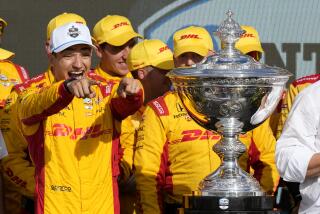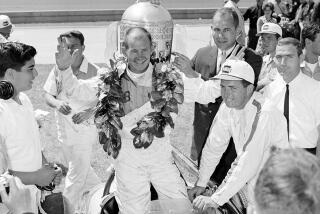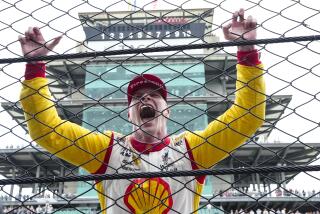Indy Car Racing Is Down to a Science
Indianapolis car owners, like Indianapolis car drivers, used to come out of garages in Torrance or Terre Haute. They had pictures of Playboy bunnies on the wall; they had screwdrivers or lug wrenches in hand and paint buckets to put “Joe’s Bar & Grill” on the side of the car if the local greasy spoon emporium ponied up enough money for the fuel.
They weren’t big on the social amenities. They didn’t wear ties. They wore cowboy boots and smoked cigars, and the only thing they ever read was a speedometer.
The cars, like the men, were right out of grass-roots America, no frills. They were often held together, if not with baling wire, at least with parts they got out of the local wrecking yard. They were half-stock, half-homemade and All-American. The engine was in the front where an engine ought to be. They could run in the rain, run in the dark and, sometimes, you could drive them to the track if you had to.
The race track was made of brick, and sometimes you went up and down as much as you went forward.
Indianapolis is as different from that now as a space shuttle is from the Wright Brothers’ contraption.
Roger Penske symbolizes the Indy owner and operator today. Roger doesn’t chew--or smoke--tobacco. He doesn’t come from a garage, he comes from a laboratory. He doesn’t wear cowboy boots, he wears Gucci loafers, tailored shirts, custom slacks, and his identifying feature is a headset into which is poured an endless stream of sophisticated cacophony.
Cars are not really driven anymore, they’re controlled. A live chauffeur may be superfluous at any moment.
Penske doesn’t watch the race on the track, he watches it on a computer. The telemetry is more important than the turns. It has been a cliche for years to claim Indy is won in the pits, but in the case of Penske’s pit, it’s more than true. It’s as programmed as a moonshot.
It’s no accident Roger Penske has had drivers in his cars who were graduates of Brown and Cornell universities and won it with a driver Gasoline Alley considered a playboy, but Penske saw as a student at military schools and the University of Kentucky.
Penske’s garages look like operating rooms, as antiseptic as a rubber glove, you could see yourself in the floor. No oil slicks dot the surface, you don’t have to worry about tripping over a lug wrench. You could perform a lobotomy on its spotless tables. His cars don’t even have any dust on them.
Indy has become almost Martian, anyway. The days of the Mom and Pop garage coming to the speedway and being competitive are as long gone as the hand crank and the thermometer on the hood. You don’t know whether they’re getting a vehicle ready for a race or a space probe.
The race hasn’t belonged to the good-old-boy set since back in the days when they ran the roadsters. You don’t win a race on the seat of your pants any more, you win it on the graphs on the screen.
Take the Indy 500 last Sunday. Rick Mears won that race with a dangerous--and uncharacteristic--slingshot move on the right-hand side of the field on Lap 188. There is an unwritten rule at Indy: You don’t ever turn right and you never pass on the right. It’s too easy to get flung up into the wall--and into Methodist Hospital.
Mears knew he could pass on the right because during his sixth pit stop--on Lap 169--the computers said he could. They said to change all the tires. So, Rick knew his tires were cool and fresh and would handle the pressure of a high-line pass even on a hot track.
The telemetry also told him the 40 gallons of fuel he took on would last for 31 laps. That was very important. Only a computer can tell you a full load will go 31 laps (77.5 miles).
His chief competitor, Michael Andretti, had pitted only three laps before, on the 166th. But his crew couldn’t bank on finishing. The electronic reassurance was not forthcoming. Michael Andretti had to make a seventh pit stop--one more than Mears. It cost him the race. He lost the race by 3.1 seconds. His seventh pit stop was 11 seconds.
Mears, of course, still had to get around him. But without that final pitting, he would not have been close enough.
Roger Penske just knows something more about setting up and operating a race car than the rest of them do. He is like Nicklaus in golf, Tony La Russa in baseball, Vince Lombardi or Bill Walsh in football.
He has won eight Indianapolis 500s. He has put a car on the pole l0 times. He has won 17 500-mile races and 64 Indy car races in all.
An Indianapolis 500 car is a 1,500-pound, high-strung, temperamental, willful bundle of rebellious nerve endings. It takes a considerable driver to tame one of them. But it takes a considerable owner to break and train it. Penske wants every part to be engineered just right. That includes the driver.
It may not be as romantic as the old days. But Mears-Penske took home $1,219,704 for winning Indy. That has its own kind of romance.
More to Read
Go beyond the scoreboard
Get the latest on L.A.'s teams in the daily Sports Report newsletter.
You may occasionally receive promotional content from the Los Angeles Times.










